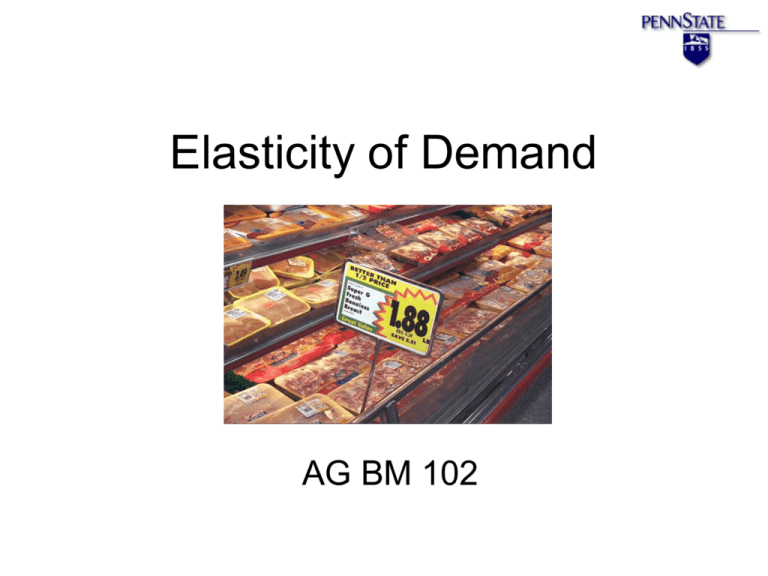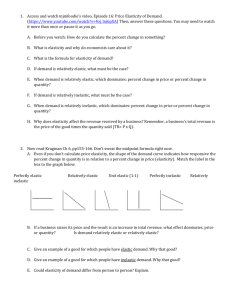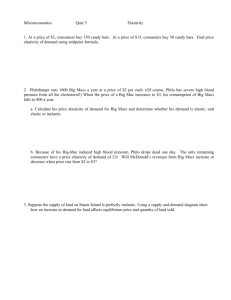Elasticity of Demand
advertisement

Elasticity of Demand AG BM 102 Introduction • Key issue: how responsive is the consumption of a product to a change in its price? • The demand curve provides a quantitative answer • But the answer depends on units of measurement • Elasticity does not depend on units of measurement! Definition: The own price elasticity of demand - the percentage change in the quantity demanded in response to a one percent change in the price of the product An Example - Beef Price/lb. Price/lb. $5.00 Quantity lb./cap. 50 $3.75 Quantity lb./cap. 75 $4.75 55 $3.50 80 $4.50 60 $3.25 85 $4.25 65 $3.00 90 $4.00 70 $2.75 95 Beef Demand 5 $/lb. 4 3 2 40 50 60 70 80 lbs./capita 90 100 Calculating the Equation for the Demand Curve • Take any two points, such as $4.00 and 70 lb, and $3.00 and 90 lb. • The equation for a straight line is Q=a+bP • In that equation a and b are constants that together define a specific line. • You did this with x and y in algebra Q a bP b (Q1 Q2) / ( P1 P 2) a Q1 bP1 Q ! 70lbs., P1 $4.00, Q2 90lbs. and b (Q1 Q2) / ( P1 P 2) b (70 90) / (4 3) 20 a Q1 bP1 a 70 ( 20) 4 150 Q a bP Q 150 20 P P 2 $3.00 Check to see if points are on the line Q = 150 – 20P P = 4, Q = 150 - 20 (4) = 70 P = 5, Q = 150 - 20 (5) = 50 Formula for Demand Elasticity (Q Q1) / (Q1) / ( P P1) / ( P1) 2 2 Note: ε is the Greek letter epsilon Elasticity at P=$4.00 and Q=70 lbs. (Q2 Q1) / (Q1) / ( P2 P1) / ( P1) (90 70) / (70) / (3 4) / (4) 114 . Interpreting elasticity • Inelastic • Elastic • Unitary elastic 0 1 1 1 Inelastic demand means that the quantity change is proportionately less than the price change Demand is not especially price responsive – an example, the demand for milk Elastic demand means that the quantity change is proportionately more than the price change. Demand is particularly price responsive – an example, the demand for lobster Another view of the formula Point elasticity (Q Q1) / (Q1) / ( P P1) / ( P1) 2 2 (Q2 Q1) / ( P2 P1) *( P1) / (Q1) b( P1 / Q1) Note • The units cancel out, so elasticity is not dependent on the units used in the data • For straight-line demand curves, the value of the elasticity changes as you move along the line • The closer you are to the vertical axis the more elastic is demand • The closer to the horizontal axis the more inelastic is demand Elasticity at P=$5.00 and Q=50 lbs. b P / Q 20 (5 / 50) 2.0 Elasticity at P=$4.00 and Q=70 lbs. b P / Q 20 (4 / 70) 114 . Some demand issues • Is the demand for all food elastic or inelastic? • Is the demand for all meat elastic or inelastic? • Is the demand for beef elastic or inelastic? • Is the demand for prime rib elastic or inelastic? Concluding comments • Elasticity allows us to talk about demand without worrying about the units of measurement • It makes discussion of demand curves easier • Makes analysis of changes in demand easier









